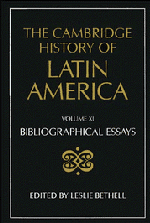Book contents
- Frontmatter
- I THE INDIGENOUS PEOPLES OF MIDDLE AND SOUTH AMERICA ON THE EVE OF THE CONQUEST
- II COLONIAL SPANISH AMERICA
- III COLONIAL BRAZIL
- 1 The Portuguese settlement of Brazil, 1500–1580
- 2 Portugal and Brazil, 1580–1750
- 3 Portugal and Brazil, 1750–1808
- 4 Population
- 5 Plantations and peripheries, c. 1580–c. 1750
- 6 Indians and the frontier
- 7 The gold cycle, c. 1690–1750
- 8 Late colonial Brazil, 1750–1808
- 9 The Catholic church
- 10 Architecture and art
- IV THE INDEPENDENCE OF LATIN AMERICA
- V LATIN AMERICA: ECONOMY, SOCIETY, POLITICS, c. 1820 TO c. 1870
- VI LATIN AMERICA: ECONOMY, SOCIETY, POLITICS, c. 1870 to 1930
- VII LATIN AMERICA: ECONOMY, SOCIETY, POLITICS, 1930 to c. 1990
- VIII IDEAS IN LATIN AMERICA SINCE INDEPENDENCE
- IX LATIN AMERICAN CULTURE SINCE INDEPENDENCE
- X THE INTERNATIONAL RELATIONS OF LATIN AMERICA SINCE INDEPENDENCE
- THE CAMBRIDGE HISTORY OF LATIN AMERICA
7 - The gold cycle, c. 1690–1750
from III - COLONIAL BRAZIL
Published online by Cambridge University Press: 28 March 2008
- Frontmatter
- I THE INDIGENOUS PEOPLES OF MIDDLE AND SOUTH AMERICA ON THE EVE OF THE CONQUEST
- II COLONIAL SPANISH AMERICA
- III COLONIAL BRAZIL
- 1 The Portuguese settlement of Brazil, 1500–1580
- 2 Portugal and Brazil, 1580–1750
- 3 Portugal and Brazil, 1750–1808
- 4 Population
- 5 Plantations and peripheries, c. 1580–c. 1750
- 6 Indians and the frontier
- 7 The gold cycle, c. 1690–1750
- 8 Late colonial Brazil, 1750–1808
- 9 The Catholic church
- 10 Architecture and art
- IV THE INDEPENDENCE OF LATIN AMERICA
- V LATIN AMERICA: ECONOMY, SOCIETY, POLITICS, c. 1820 TO c. 1870
- VI LATIN AMERICA: ECONOMY, SOCIETY, POLITICS, c. 1870 to 1930
- VII LATIN AMERICA: ECONOMY, SOCIETY, POLITICS, 1930 to c. 1990
- VIII IDEAS IN LATIN AMERICA SINCE INDEPENDENCE
- IX LATIN AMERICAN CULTURE SINCE INDEPENDENCE
- X THE INTERNATIONAL RELATIONS OF LATIN AMERICA SINCE INDEPENDENCE
- THE CAMBRIDGE HISTORY OF LATIN AMERICA
Summary
Studies on the ‘golden age’ of Brazil have focused on only one area, Minas Gerais, which was the major gold-producing region of the colonial period. There has been an erroneous assumption that what was true for Minas Gerais was equally applicable to auriferous zones of Bahia, São Paulo, Goiás, Mato Grosso, Pernambuco and Espírito Santo. Readers should be cautious of generalizations based on the Mineiro experience and recognize that differences in topography, chronology, demography, racial composition, political importance, degree of effective crown administration and relative importance within the overall economic context resulted in wide variations among the gold-bearing regions of Brazil. The diamond industry lies beyond the scope of this essay, but an excellent introduction is provided by Augusto de Lima Júnior, História dos diamantes nas Minas Gerais (Lisbon and Rio de Janeiro, 1945) and Joaquim Felício dos Santos, Memórias do distrito diamantino da comarca do Serra do Frio, 3rd ed. (Rio de Janeiro, 1956).
Many contemporary or near-contemporary accounts of gold strikes, exploitation, consolidation and decline are available. André João Antonil (pseudonym of Antonio Giovanni Andreoni, S.J.) is valuable for the early years in Minas Gerais, although it is doubtful he ever visited the region. Available in a modern edition (edited by Andrée Mansuy, Paris, 1968), his Cultura e opulência do Brasil por suas drogas e minas (Lisbon, 1711), especially part 3, contains information not available elsewhere. It remains unsurpassed for bringing to the reader the intensity and raw emotions of the initial gold rush. Dr. Caetano Costa Matoso’s notes form the basis for the Relatos sertanistas: Colectânea, with introduction and notes by Afonso de Escragnolle Taunay (São Paulo, 1953).
- Type
- Chapter
- Information
- The Cambridge History of Latin America , pp. 197 - 206Publisher: Cambridge University PressPrint publication year: 1995



